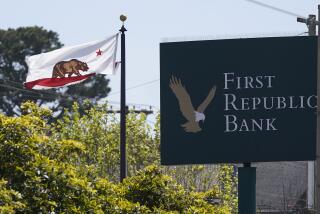Federal Deposit Insurance Goes Under Review : Savings: Congress wants to restore the confidence of depositors but doesn’t want financial institutions to take unreasonable risks.
- Share via
WASHINGTON — Federal deposit insurance had a mixed record during the 1980s: It prevented panic in the streets by nervous savers but also provided the fuel for disastrously risky new ventures by savings and loan associations.
Today Congress begins the difficult task of reforming the insurance system to handle banking in the 1990s. Once again, the legislators want to bolster the shaken confidence of depositors. But they also want U.S. savings institutions to take more reasonable risks, seeking out new lines of business as they compete with capital-rich Japanese banks.
The House Banking Committee will begin considering a number of proposals as it conducts hearings today. For example, some members of Congress would require banks and S&Ls; to seek private insurance for high-risk ventures instead of relying on the federal insurance, which guarantees deposits up to $100,000. Some may also argue that the government should lower the $100,000 ceiling for guaranteeing deposits. Still others may press for limiting deposit insurance to $100,000 per person, not per account.
Fewer than 10% of Americans had liquid financial assets--cash, savings and checking accounts, certificates of deposit--over $40,000 in 1980, when Congress boosted the deposit guarantee limit from $40,000 to $100,000. Brokerage houses eagerly solicited the money of wealthy investors in search of the highest safe yield, split the money into increments of $100,000 and sent it racing throughout the country.
The money poured into S&Ls;, and too many managers sent it surging out again for use in dubious ventures: raw land, horse-breeding farms, shopping centers in already jammed retail markets, condominiums with no chance of an economic payoff.
Rep. Henry B. Gonzalez (D-Tex.), the House Banking Committee chairman, has questioned whether the insured ceiling is too high and whether wealthy savers should be allowed to have numerous accounts.
“Not only do we need to examine the absolute limits of the coverage,” said Gonzalez, “but (we need) to determine whether the multiple accounts maintained by some depositors are unnecessarily increasing the risks to the (deposit insurance) funds.”
However, it seems unlikely that Congress would agree to roll back the $100,000 guarantee for fear that the public might view this as a retreat from vital protection of savings.
“To seek to lower the $100,000 limit at this time would severely impact on encouraging individual savings and may well have a negative effect on the health of financial institutions,” said Rep. Bruce Vento (D-Minn.), a member of the banking committee.
But members agree that there will be a serious discussion of ways to remove deposit protection from risky activities to prevent a repetition of the investment excesses of the 1980s.
Gonzalez said he wants to examine “private insurance possibilities, particularly for high-risk activities and for extended coverage beyond that provided by the federal insurance funds.” A revised insurance mechanism will become essential to any discussion of granting new powers to banks, allowing their widespread involvement in the securities and insurance fields.
L. William Seidman, chairman of the Federal Deposit Insurance Corp., has previously proposed that higher-risk activities be placed in subsidiaries with their own capital, and rigidly separated from the savings institutions. If the insurance or brokerage business is failing, it would get no rescue funds from the parent bank or from the federal government, and the collapse won’t harm the bank.
Segregating conventional banking from higher risk ventures would be a better answer than cutting back the amount of deposits eligible for insurance, said an FDIC official. “In today’s electronic computer-driven age, it is not much more difficult for brokers to split $1 million into 20 accounts of $50,000 each, than it was to create 10 accounts of $100,000,” the official said.
S&L; consultant Bert Ely suggests that the ultimate solution is a private insurance system, with banks and S&Ls; creating pools to provide insurance coverage for each other. Financial institutions taking bigger risks would pay higher premiums for insurance. Under the current system, there is no separate recognition for risk.
The federal government insurance fund would be a backup in case the industry insurance failed, said Ely.
More to Read
Inside the business of entertainment
The Wide Shot brings you news, analysis and insights on everything from streaming wars to production — and what it all means for the future.
You may occasionally receive promotional content from the Los Angeles Times.










